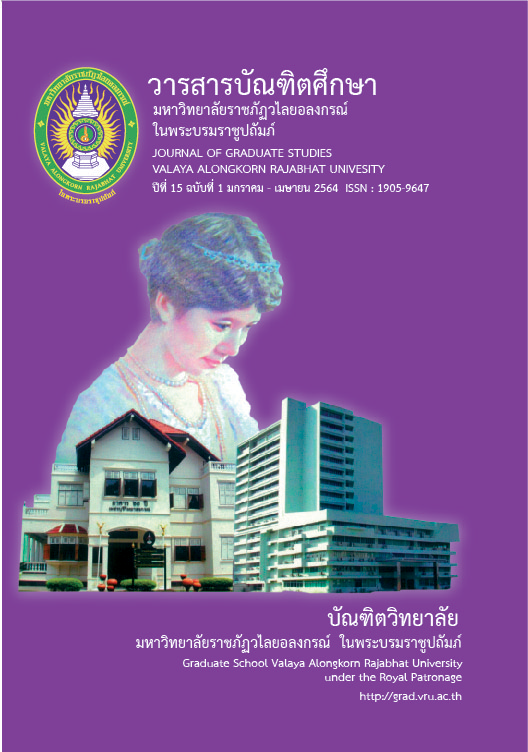A STUDY FACTOR IN LEARNING MANAGEMENT FOR STUDENT OF THE TEACHING PROFESSION BACHELOR DEGREE TO HAVE TECHNIQUES OF ACTIVITIES MANAGEMENT
Main Article Content
Abstract
The objectives of this research were to 1) study and synthesis of learning management components for teachers department of Mathematics, Bachelor degree to have techniques for organizing learning activities, and 2) study the teaching techniques of students in the teaching profession department of Mathematics Faculty of Education, Valaya Alongkorn ajabhat University under the Royal Patronage. The sample used in this research consisted of 51 the 3rd year from undergraduate students in mathematics in the first semester of the academic year 2018, by selective purposive sampling. The tool used in this study were the interview form and summary form of teaching and learning activities. The Statistics used for data used content analysis, frequency distribution and percentage.
The research found that: 1) Learning management components for teachers department of Mathematics, Bachelor degree to have techniques for organizing learning activities there is a continuous cycle of 3 components, which are (1) plan, (2) actions to achieve learning, and (3) reflection. 2) Teaching techniques for teachers Bachelor degree to have techniques for organizing learning activities students organize learning activities use 8 techniques, which are (1) introduction, (2) explanation and examples, (3) verbal and nonverbal communication, (4) use a blackboard or whiteboard ,(5) use questions, (6) reinforcement, (7) use of instructional media, and 8) use music.
Article Details
บทความทุกเรื่องได้รับการตรวจความถูกต้องทางวิชาการโดยผู้ทรงคุณวุฒิ ทรรศนะและข้อคิดเห็นในบทความวารสารบัณฑิตศึกษา มหาวิทยาลัยราชภัฏวไลยอลงกรณ์ ในพระบรมราชูปถัมภ์ มิใช่เป็นทรรศนะและความคิดของผู้จัดทำจึงมิใช่ความรับผิดชอบของบัณฑิตวิทยาลัย มหาวิทยาลัยราชภัฏวไลยอลงกรณ์ ในพระบรมราชูปถัมภ์ กองบรรณาธิการไม่สงวนสิทธิ์การคัดลอก แต่ให้อ้างอิงแหล่งที่มา
References
Arends, R. I. (2001). Learning to teach (5th ed.). Singapore: McGraw-Hill.
Dechakupt. P., & Yindeesuk, P. (2018) . kānčhatkān rīanrū nai satawat thī 21. Krung Thēp...: rōngphim hǣng Čhulālongkō̜nmahāwitthayālai .[Social Studies Learning Management in the 21st Century.] Bangkok: Publisher of Chulalongkorn University.
Eggen, P. D. & Kauchak, D. P. (2006). Strategies and Models for Teachers: Teaching content and thinking Skills. Boston: Pearson.
Juithong.S. (2016). khō̜ng kānphatthanā rūpbǣp kānčhatkān rīanrū tām nǣo kānsō̜n khō̜ng khrū phū sō̜n khanittasāt dīdēn thī mī tō̜ phon samrit thāngkān rī khanittasāt khō̜ng nakrīan chan prathomsưksā pī thī hok .[The effects of development of learning management model according to the teaching of mathematics outstanding teachers toward mathematics learning achievement of sixth grade students.] Journal of Graduate Studies Valaya Alongkron Rajabhat University.10(3) : 178-191.
Khemmanee.T. (2018). sāt kānsō̜n : ongkhwāmrū phư̄a kānčhat krabūankān rīanrū thī mī prasitthiphāp Phim khrang thī 23. Krung Thēp Mahā Nakhō̜n : Čhulālongkō̜nmahāwitthayālai. [Teaching science: knowledge for effective learning process management. The 22nd edition].Bangkok: Publisher of Chulalongkorn University.
Newby, T.J., Lehman, J., Russell, J. & Stepich, D.A. (1999). Instructional Technology for Teaching and Learning: Designing Instruction, Integrating Computers, and Using Media (2nd ed.). New Jersey: Prentice- Hall.
Piaget, J. (2001). The child's conception of physical casuality. New York: McGraw–Hill.
Smith, P. L. & Ragan, T. J. (1999). Instructional design (2nd ed.). New Jersey: Prentice Hall.
Tyler, Ralph W. (1950). Basic Principles of curriculum and Instruction. Chicago: The University of Chicago press.
Wilen, W., Hutchison, J. & Bosse M. I. (2008). Dynamics of effective secondary teaching (6th ed.). Boston: Allyn and Bacon.


